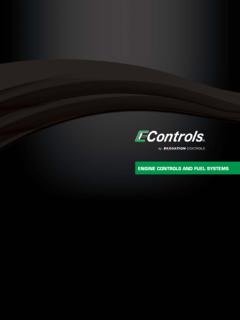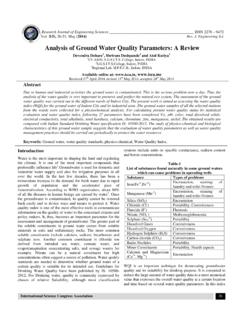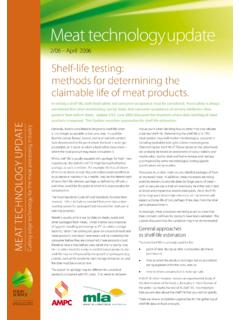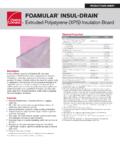Transcription of A Review of Accelerated Durability Tests - VAMAS
1 Technical Working Area 12 Efficient Test Procedures for Polymer Properties A Review of Accelerated Durability Tests Compiled and Edited by R P Brown R P Brown, D Kockott, P Trubiroha, W Ketola and J Shorthouse September 1995 VAMAS Report No. 18 ISSN 1016-2186 Versailles Project on Advanced Materials and Standards Canada, EC, Germany, France, Italy, Japan, UK, USA VAMAS Technical Report No 18 Crown copyright 1995 National Physical Laboratory Teddington, Middlesex TW11 0LW, UK Extracts from this report may be reproduced provided the source is acknowledged.
2 Approved on behalf of Chief Executive, NPL, by Dr M K Hossain, Division of Materials Metrology VAMAS Technical Report No 18 CONTENTS Page 1 1 2 1 3 THE OBJECTIVES OF Accelerated 1 4 THE DEGRADATION 2 5 DEGRADATION MECHANISMS IN 3 6 FUNDAMENTAL PROBLEMS OF Accelerated 5 7 COMPARISON WITH NATURAL 5 8 PUBLISHED 5 9 STEPS IN DESIGNING AN Accelerated TEST 6 10 PREDICTIVE TECHNIQUES AND 6 INTRODUCTION .. 6 ARRHENIUS RELATIONSHIP AND EFFECT OF 8 ARTIFICIAL 9 EFFECT OF 10 DYNAMIC 11 11 11 VARIABILITY AND 12 REPEATABILITY AND REPRODUCIBILITY .. 12 UNCERTAINTY OF RESULTS CAUSED BY POOR 15 18 12 TEST PIECE 18 13 HEAT 19 EQUIPMENT.
3 19 TEST PIECES .. 20 TEST 20 14 21 EQUIPMENT .. 21 21 Temperature .. 22 Water/Humidity .. 23 REPRODUCIBILITY OF Accelerated WEATHERING RESULTS .. 23 TESTING COMPLETE COMPONENT PARTS .. 24 15 EXPOSURE TO 24 EQUIPMENT .. 24 TEST PIECES .. 24 TEST 25 16 EXPOSURE TO 25 EQUIPMENT .. 25 TEST PIECES .. 26 TEST 26 17 IONISING 26 SOURCE .. 26 Types of Radiation .. 26 27 INTENSITY .. 27 TEMPERATURE.
4 27 EXPOSURE STRATEGY .. 28 Simulation by beta versus gamma 28 Estimation of test 28 Dose rate .. 28 Exposure temperature .. 29 Environment .. 29 Physical considerations .. 29 EVALUATION .. 30 18 PARAMETERS TO MONITOR 30 19 PITFALLS IN Accelerated 32 20 SIMULATED DESIGN LIFE EXPOSURE OF 33 21 APPENDIX 34 APPENDIX 37 VAMAS Technical Report No 18 A Review of Accelerated Durability Tests R P Brown (RAPRA Technology Limited) under contract from Division of Materials Metrology National Physical Laboratory Queens Road, Teddington, Middlesex TW11 0LW ABSTRACT This Review formed part of the work programme of VAMAS Technical Working Area 12 (TWA12) and followed from a detailed survey that examined the availability, status and usage in the VAMAS countries of accelreated Durability Tests and is aimed at assisting the development of an ISO standard.
5 It includes information on degradation agents and mechanisms, published standards, designing an Accelerated Durability testing programme, predictive models, variability and uncertainty, heat ageing, weathering, exposure to liquids and gases, ionizing radiation, pitfalls, and simulated design life exposure of products. Compiled and edited by R P Brown, RAPRA Technology Ltd, Shawbury, Shrewsbury, Shropshire SY4 4NR, UK with contributions from: D Kockott, Consultant, Vogelsbergstrasse 27, D-6450 Hanau 7, Germany P Trubiroha, BAM, Unter den Eichen 87, D-1000 Berlin 45, Germany W Ketola, 3M Company, Bldg 553-A, 3M Center, St Paul, Minnesota 55144, USA J Shorthouse (retired), Nuclear Electric plc, Booths Hall, Chelford Road, Knutsford, Cheshire WA16 8QG, UK VAMAS Technical Report No 18 1 1 INTRODUCTION By definition Durability of a material or product implies its performance over a long time scale.
6 The expected life span of polymer products varies considerably but is generally measurable in years and can be 20 or even 50 years. With such time scales it becomes virtually impossible to prove a product under service conditions over its whole design life and it becomes necessary to rely on Accelerated Tests to predict long term performance. There is hence an enormous need for reliable Accelerated testing methods and prediction techniques which is only matched in magnitude by the inherent difficulties of designing Tests which can be relied upon to give meaningful predictions. Whilst large amounts of Durability data are produced by Accelerated methods, relatively little has been validated as realistically representing service and there is great scepticism on the part of both polymer suppliers and end users as to the value of any Accelerated data. Nevertheless there is much valuable information which has resulted from studies of polymer Durability which can be applied to help maximise the value of any Accelerated testing programme.
7 It is the object of this Guide to make such information readily available. 2 SCOPE Durability in its broadest sense covers any aspect of irreversible property change with time and use. For the purposes of this work, the scope is restricted to the effect of the environment ie dynamic mechanical degradation such as abrasion and fatigue is excluded. However, any test to measure the effect of the environment can use any mechanical, physical or chemical parameter, including abrasion or fatigue to monitor change. The environment includes heat, light, liquids, gases and ionising radiation. 3 THE OBJECTIVES OF Accelerated Tests Accelerated Durability Tests may be carried out for different purposes and with different objectives in mind. The reasons for Accelerated testing may be summarised as:- Product performance prediction Comparison of materials Quality assurance Design data It is important that the purpose and objective of testing is clearly established because they will influence to a considerable degree the design of the Durability trial and the interpretation of the results.
8 Simplistically, when the purpose is simple comparison or a check against a given specification the critical dependence of the value of the results on the relation of the test conditions to real service is much reduced. This does not mean that test conditions are unimportant for comparison or quality checks but their relevance to service need not be so rigorously proven. When the results are to be used for performance prediction or design it is essential that extrapolation rules from the test conditions to those of service are known and that they can be used with confidence. The essential requirement for comparison is that the test conditions are not such that they give a distorted view of relative performance. For quality assurance it is also particularly important that test conditions are standardised and reproducible. VAMAS Technical Report No 18 2 The purpose of the trial will also influence the time scales, the number of experimental points, the choice of degradation agents and the parameters to be measured.
9 For example, comparison and quality check trials may achieve their purpose with comparatively short time scales and/or experimental points. Whereas multiple degradation agents may be more realistic as regards service, this will make extrapolation rules more complicated. The choice of parameter to be measured will in part depend on whether a general assessment is being made or the interest is in a particular parameter critical to performance. There are of course many other considerations which will affect the choice of test conditions. Having defined the objectives of the trial and in the light of these decided on the details of test conditions and analysis of results, it will be possible to state the limitations of the results and hence estimate their significance. 4 THE DEGRADATION AGENTS These can be summarised as:- Heat Light Liquids Gases Radiation Mechanical stress Electrical stress In Durability testing, heat as a single agent is generally taken to mean the action of both temperature and atmospheric oxygen.
10 Hence a test for effect of temperature must consider the availability of oxygen and its diffusion in the test piece. Heat is also very commonly used in combination with other agents, notably light, liquids and other gases. Light may extend beyond the visible range, particularly to the UV region. Liquids encompass a whole range of chemicals either pure or solutions which may be applied to the test pieces by immersion or by such particular means as salt spray or high humidity. Gases may include the use of an inert gas atmosphere to exclude oxygen. Radiation covers x and gamma radiation and the various nuclear particles. Heat, light, liquids, gases and radiation are collectively known as aggressive environments. For the purpose of this guide the effects of mechanical and electrical stress are not considered in isolation but are treated either as an additional test condition to enhance the effect of the aggressive environment or as a parameter to measure the effect of the environment.








